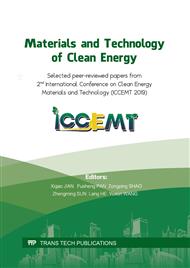p.100
p.109
p.117
p.129
p.136
p.145
p.155
p.167
p.178
Effects of Direct Coal Liquefaction Residue Additions on Low-Rank Pulverized Coal during Co-Pyrolysis
Abstract:
This study examined the co-pyrolysis characteristics of low-rank coal (SJC) and direct coal liquefaction residue (DCLR) through thermogravimetric analysis coupled with Fourier transform infrared spectrometry. It also investigated the influences of different mass fractions of DCLR to SJC on the co-pyrolysis characteristics and release regulation of gas phase components. Results showed that with increasing DCLR content, coke yield initially decreased and then increased, but tar and gas yield reversed. Different addition of DCLR changed the composition of the pyrolysis gas in various degrees, and reduced the content of-OH and nitrogen compounds in coke. The H2 content in the gas gradually increased. When 40% DCLR was added, the maximum tar yield was 22.79%, and the maximum H2 yield was 37.12%. At 60% DCLR, the lowest semi-coke yield was 65.01%, and the highest gas yield was 14.65%. The co-pyrolysis of SJC and DCLR can be divided into three stages. The first was the dry degassing stage, during which the adsorbed gas and small-molecule gas were removed on the coal surface at room temperature to 350 °C. The second stage (350 °C–650 °C) was the intense pyrolysis reaction stage, during which a large number of volatiles were obtained. The substantial weight loss rate peak appeared around 450 °C. The weight loss rate of pyrolysis gradually increased with increasing DCLR dosage. The co-pyrolysis of SJC and DCLR was not a simple sum between SJC and DCLR, which indicated a synergistic effect in the co-pyrolysis. The synergistic effect between SJC and DCLR enhances the interaction between free-radical fragments, thereby increasing the yield of pyrolysis tar. The third stage was the shrinkage of semi-coke from 650 °C to the end of the reaction. The polycondensation reaction between free-radical fragments to form solid coke with higher aromaticity, and H2 released.
Info:
Periodical:
Pages:
167-177
Citation:
Online since:
June 2020
Authors:
Price:
Сopyright:
© 2020 Trans Tech Publications Ltd. All Rights Reserved
Share:
Citation:


